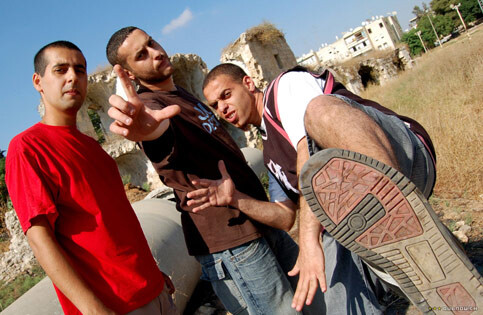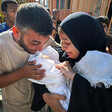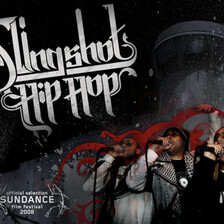The Electronic Intifada 10 September 2008

DAM (Slingshot Hip Hop)
Jackie Salloum’s invigorating new documentary Slingshot Hip Hop portrays the story of three aspiring Palestinian musicians from the rap group DAM as they develop their talent in their bedrooms and take it to standing-room-only crowds throughout historic Palestine. The youth from Lyd, inside present-day Israel, start off mimicking the gestures and English lyrics of the US rappers they see on TV, their songs celebrating materialism devoid of the social justice message upon which the genre of hip-hop was founded. However, this changes as the musicians’ political awareness is sharpened by the rapid deterioration of the human rights situation in Palestine and they begin to see themselves in the images of America’s oppressed black urban youth. Instead of performing empty songs to Jewish Israeli party-goers, as they did before their political awakening, DAM begin performing Arabic-language raps celebrating Palestinian literary figures, and decrying the realities of Palestinian life under Israeli rule in front of ever-growing crowds of Palestinian youth.
DAM’s artists, brothers Tamer and Suhell Nafar and Mahmood Jrere, are part of Israel’s internally displaced Palestinians — the descendants of those who in 1948 were forced from their homes in places like Haifa, Nazareth and Jaffa but remained inside the 1949 ceasefire line, the internationally-recognized demarcation between Israel and the occupied West Bank and Gaza Strip (Israel has never declared its borders).
Though the DAM crew may hold Israeli passports, their lyrics about discrimination, resisting oppression and pride in a common heritage ring true with young Palestinians everywhere. Indeed, the musicians from Lyd might find a feeling of familiarity in the southern Gaza Strip, where Mohammed al-Farra from the group Palestinian Rapperz (PR) lives. Whether in the Gaza Strip, or in Lyd, Palestinians are subject to Israel’s racist policies of house demolitions and arbitrary arrest. “It’s like a refugee camp in Israel,” DAM’s member Tamer Nafar says of Lyd, where a lack of community services, unemployment, and poverty bred by systemic state discrimination makes drug use an attractive escape for many young people.
DAM’s work inside their own community is especially significant. The group visits a camp for children (called Camp Return, referring to Palestinian refugees’ right of return) in Lyd. After Tamer performs an unaccompanied rap describing his pride in being Palestinian (“Remove the word self-pity from your mind … raise our heads high”), one of the children in the audience asks with genuine surprise, “I’m a Palestinian?” When the rappers gently ask him what he thought he was, he replies, “just Arab,” indicating the internalization of Israel’s attempts to strip Palestinians inside Israel of their national identity.
Salloum’s film shows the audience how these artists are using a cultural medium to unite Palestinian youth who have grown up not knowing their peers in other parts of the Palestinian Diaspora, and how their themes of repression and subjugation communicate their common story of injustice. In Gaza, PR’s Mohammed al-Farra echoes Tamer Nafar and his comrades when he explains that he and his crew turned to rapping as a form of release and resistance following Israel’s brutal repression of the second Palestinian intifada which broke out in 2000. In November of that year, Mohammed narrowly escaped death when he turned his body just in time for an Israeli-fired bullet to penetrate his arm instead of his heart. Filled with despair, Mohammed struggled to find rap CDs in Gaza’s music stores, and was riveted when a friend brought back an Eminem CD from Canada. But he found his direction when he heard DAM on the Internet. Now, he says, his dream is to meet his “brothers in ‘48,” referring to the part of historic Palestine that is now considered to be Israel proper and to which Palestinians in Gaza and the West Bank are prohibited from freely visiting.
Likewise, two teenagers in the West Bank’s Deheisheh refugee camp named Bilal and Rami seek DAM’s mentorship, Mahmoud Shalabi, another Palestinian rapper who holds Israeli citizenship. The two boys want the rappers’ help in writing rap lyrics to honor their friend Kifah who was shot and killed by the Israeli army during an invasion of Deheisheh. Risking arrest by traveling to the West Bank, DAM perform their iconic anthem “Meen Erhabe?” (Who’s the Terrorist?) that has been downloaded from the Internet more than one million times. Their Deheisheh audience know all the lyrics. “In Israel we feel disconnected,” says Mahmoud Shalabi. “But here, I feel connected with who I am.” Salloum’s audience learns that a few short months after they performed their tribute to their slain friend, Bilal and Rami were arrested and accused of throwing stones at the Israeli army two years prior. Bilal tells DAM over the phone that the military prosecution wants to sentence Rami to 10 years, whereas Bilal faces less time, and he says that they have been subjected to mental and physical abuse and torture.
Salloum lets the musicians featured in her film tell their individual stories (Slingshot is narrated by DAM’s Suhell Nafar) and through their testimonies the viewer gets a sense of what it means for Palestinians to live under Israeli rule. Their individual stories are put into historical context, provided by brief animations illustrating the expulsion of Palestinians from their homeland and its colonization by Israel. Salloum intertwines her documentary footage with that from news archives, including English-language Israeli broadcasts that ominously refer to Palestinians with Israeli citizenship as a threat from within. With this backdrop, it’s not hard to believe Mahmoud Shalabi when he describes the nasty looks he gets from Jewish Israelis simply because he is speaking his first language, and at one point he is stopped on the street by police. The only time that one the film producers’ voices is heard is when a woman off camera asks whether Mahmoud was being detained on a Tel Aviv street simply because he was speaking Arabic. “Yes,” the Israeli officer replies, in a surprised tone that suggests how deep-seeded racism is in Israel.
Further illustrating the severity of discrimination faced by Palestinians in Israel, viewers meet Suhell and Nafar’s cousin Abeer, who gained some recognition a few years ago after she successfully protested being fired from McDonald’s Israel because she spoke Arabic. Abeer continues to resist being silenced, no matter who is attempting to keep her quiet. She is encouraged by her cousins to perform, and records a song with them urging women particularly to refuse to be silenced, “Sawt al-Samt” (The Sound of Silence). DAM do not divorce social justice from political justice, and actively reach out to and encourage female performers to develop their talent. The film relates that despite support from her parents, Abeer was dissuaded from performing with Tamer and Suhell on television, by strong opposition from some of her extended family. Despite her disappointment she continues to practice her lyrics at home (“I’m just doing it because there’s no other reason to live,” Abeer explains) and eventually joins her cousins on stage.
Abeer is featured in one of the most rewarding moments of Salloum’s film, when Mohammed al-Farra and the other members of PR make their debut in Gaza. Viewing the video of PR’s performance back in Lyd, Abeer remarks on the large audience and exclaims, “Are you sure it’s their first show? Because they’re so confident and they’re not afraid … If I didn’t know I’d say this was in Tunisia or Algeria, not Gaza.” One of her cousins explains their confidence: “These guys stand in front of guns and tanks.” And when Salloum’s audience meets Gazan rapper Ibrahim, who is from a largely destroyed residential area in the southern Gaza Strip, it’s no surprise why he raps with the passion he does. The buildings that remain standing after Israeli air attacks resemble the infamous bullet-ridden structures of civil war-era Beirut or London during the Blitz. However, rap can only do so much for an individual who lives in such extreme circumstances and describes seeing “all of the colors of the rainbow” at night because of Israel’s constant bombardment. “No matter how I try I’m still not able express my feelings, especially the devastation,” Ibrahim explains.
The story Salloum presents in her film, which took several years to produce and belies its minimal funding, feels unresolved, as perhaps it should. The work of these artists is not yet done and there will surely be waves of young musicians who to follow. Indeed, the most obvious criticism of the film is that it does not give a fuller picture of the phenomenon of Palestinian hip-hop by giving mention to Palestinian rappers from other parts of the Diaspora, like the Philistines in the US and Khatibe Khamse in Lebanon, and the extent of cooperation between Palestinian rappers outside of historic Palestine with each other and those inside. However, it is easy to see how the filmmaker would be necessarily limited to documenting the rise of the musicians living in historic Palestine, while it just so happened that young Palestinians in other parts of the world began turning to rap to express themselves as the genre gained global popularity.
Despite this point of criticism, the film deserves the widest audience possible as it achieves something quite significant. Following the secret Oslo negotiations of the early ’90s which disenfranchised the Palestinian Diaspora, the Israeli agenda of colonization redoubled its efforts and international law was abandoned to the wind, and the word “hope” became a laughable conceit. However, this film one of the most hope-inspiring things to come around in a long while. This viewer was left with the feeling that if any positive change does come about in the near future, it will be because of grassroots efforts like those of these artists who subvert the barriers that have been imposed on them and their people.
It is in large part the resistance of everyday people to the obliteration of their society and national identity that has kept the Palestinian nation alive despite the tribulations of Palestinian politics. This means of resistance has been passed down from one generation to the next, and Salloum’s audience is subtly shown how Tamer and Suhell Nafar’s talents have been nurtured by their parents, who express support of their sons’ trajectory even if it is wildly different than their own. In Gaza, viewers meet Mohammed al-Farra’s musical family and learn that Mohammed’s father was imprisoned for performing songs with a subversive political element. Similarly, the mother Safaa, of a young female hip-hop artist in Israel, explains, “The most important thing is being proud of who we are and what we stand for.”
Palestinian rappers mobilize and unite fellow Palestinians despite walls, checkpoints and borders. Jackie Salloum’s most recommended film presents these artists’ struggle to a global audience and helps ensure that Palestinian hip-hop finds claims its rightful place in the proud tradition of artistic resistance to oppression.
Maureen Clare Murphy is Managing Editor of The Electronic Intifada
Related Links
- Slingshot Hip Hop
- Slingshot Hip Hop comes to Lebanon, Jackson Allers (14 August 2008)
- BY TOPIC: Film reviews and features




